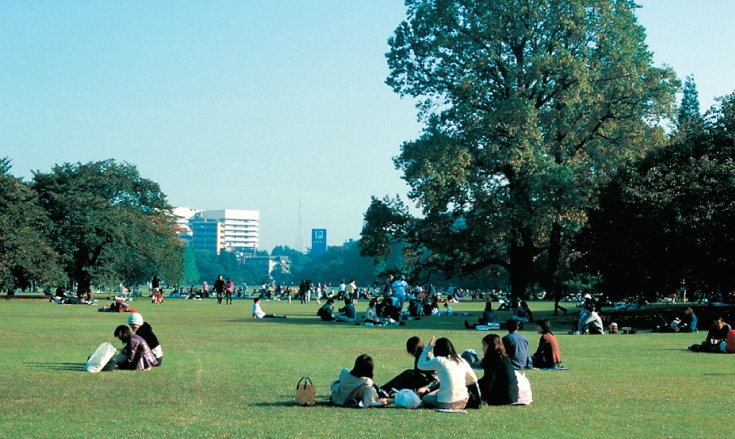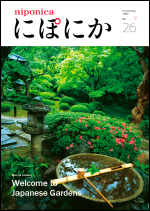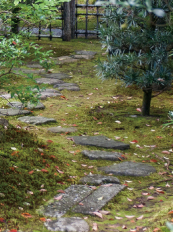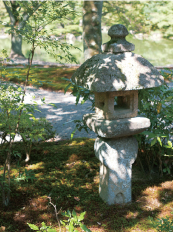niponica is a web magazine that introduces modern Japan to people all over the world.
2019 NO.26
Welcome to Japanese Gardens

Japanese Gardens –Changes in Style
12th century
Gardens of the Zen Sect

Ryoanji (Kyoto Prefecture). A typical Japanese dry landscape garden.
The Kamakura period (1185–1333) that followed the Heian period saw the rise of a warrior class and the influence of a Buddhist sect called Zen, bringing about changes in the styles of residential buildings and garden creation. It was not the custom of the warrior class, not even the military elite, to hold splendid ceremonies in their gardens.
Japanese gardens reached one of their pinnacles in the subsequent Muromachi period (1333-1568). Groups of skilled craftsmen called senzui kawaramono (people living around mountains, streams, and riverbeds - particularly gardeners) were responsible for creating a new style of garden, known as Karesansui (Japanese dry landscapes). Heavily influenced by Zen Buddhism, these gardens are characterized by extreme abstraction. Arrangement of rocks represents mountains or waterfalls, and white sand is used to replace flowing water. This form of garden cannot be seen in any other part of the world.
In addition, gardens of that period were greatly influenced by the style of architecture known as shoin-zukuri, which still serves as the prototype for current traditional style Japanese houses. The garden admired from the building is designed to give the viewer situated in a shoin (room in a shoin-zukuri building) a sense that he or she is appreciating a masterpiece of painting and to lead one to careful and extended viewing.
16th century
Tea Gardens

Tea pavilion at Sento Imperial Palace (Kyoto Prefecture)
The tea garden, imbued with tranquil spirituality, was developed in conjunction with the tea culture that was perfected by Sen no Rikyu (1522–1591), a master of tea ceremony. It was through the tea garden, which avoided artificiality and was created so as to retain a highly natural appearance, that one approached the tea ceremony house. Today’s Japanese gardens incorporate a number of elements inherited from the tea garden, such as stepping stones, stone lanterns, clusters of trees and/or washbasins. The simply designed tea pavilion in which guests are served tea also originated with the tea garden.
17th century
Kaiyu Style Gardens

A kaiyu style garden, Suizenji Jojuen Garden (Kumamoto Prefecture)
The various forms taken by gardens over the centuries culminated in kaiyu style gardens in the Edo period (1603–1867). Historic stones and tasteful trees were used to create miniature reproductions of famous scenes. People enjoyed the seasonal changes of scenery while strolling and appreciating the large ponds. The garden of the Katsura Imperial Villa in Kyoto, a creation of the early Edo period, is a typical kaiyu style garden with a pond in the center surrounded by several tea pavilions. The so-called “Three Great Gardens” in Japan - Kairakuen Garden in Mito City, Ibaraki Prefecture; Kenrokuen in Kanazawa City, Ishikawa Prefecture; Korakuen in Okayama City, Okayama Prefecture - and Suizenji Jojuen Garden in Kumamoto Prefecture are of this style created by feudal lords.
At the beginning of the Meiji period (1868–1912), western influences began extending even into traditional Japanese garden design, such as incorporating spaces with extensive lawns. Shinjuku Gyoen National Garden in Tokyo is one example.
Present

Shinjuku Gyoen National Garden with an extensive lawn area
Amasaki Hiromasa
Scholar of landscape architecture, garden creator, professor at Kyoto University of Art and Design. Awarded the Japanese Institute of Landscape Architecture Prize in 1991. After serving as President of the Kyoto College of Art and Vice President of the Kyoto University of Art and Design, took up current position as Honorary Director of Research Center for Japanese Garden Art and Historical Heritage.
Photos: Nara City Tourist Association, the Museum of Kyoto, Leemu, @fukui_norisuke, shalion/PIXTA, Sudo Koichi/Aflo, Izumi Shrine, Shinjuku Gyoen, Ministry of the Environment







